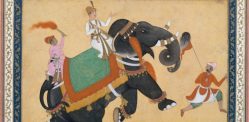The ruins tell stories of a once-thriving civilisation.
The Mainamati Ruins in Comilla, Bangladesh, is one of the richest monuments in the country.
It is beautiful with intricate architecture and strong structure.
The ruins are also frequented by tourists who enjoy the ruins and its deep culture.
However, are you seeking a deeper look into its roots and origins?
DESIblitz explores the history of the Mainamati Ruins, Comilla.
Origins
 Mainamati, a site of ancient cultural heritage, is situated in Comilla, Bangladesh.
Mainamati, a site of ancient cultural heritage, is situated in Comilla, Bangladesh.
The ruins whisper stories of an era long gone. Like a time capsule, they hold secrets of the eighth to 12th centuries.
Historians believe the site was once a thriving settlement.
Named after Queen Mainamati, the ruins are part of the ancient Samatata kingdom. This kingdom played a crucial role in the region’s development.
Archaeological excavations reveal that the area housed several learning centres.
These were places where scholars studied and exchanged knowledge. The artefacts discovered include terracotta plaques, bronze statues, and inscriptions.
Mainamati’s golden age shone under the Deva dynasty, which ruled over Samatata.
The region also saw artistic and architectural advancements over time.
Over time, invasions and natural calamities led to the site’s decline. By the 13th century, the region had fallen into obscurity.
The once-grand structures were buried under layers of earth and forgotten.
In the 1950s, British and Bangladeshi archaeologists began uncovering Mainamati’s splendour.
What they found was remarkable—several historic sites, complete with stupas, structures, and relics.
Their discoveries shed light on a civilisation with a rich cultural and artistic history.
Architectural Features
 The ruins showcase Pala-style architecture, famous for intricate designs and solid brick structures.
The ruins showcase Pala-style architecture, famous for intricate designs and solid brick structures.
The main sites include Shalban Vihara, Kutila Mura, and Ananda Vihara.
Shalban Vihara
Shalban Vihara stands as the most significant structure in Mainamati.
Built in the eighth century, its symmetrical layout reflects careful planning.
The site consists of 115 rooms surrounding a central courtyard and a main structure.
Archaeologists found bronze statues, inscriptions, and terracotta plaques. The plaques depict scenes from daily life and historical events.
Shalban Vihara also had a sophisticated water management system. This included a series of ponds and wells, ensuring access to clean water throughout the year. Such planning highlights the advanced knowledge of engineering during that period.
Kutila Mura
Kutila Mura, another famous site, features three main structures. The site also contains several small stupas, hinting at a place of significance.
The design of Kutila Mura reflects the blend of the Gupta and Pala architectural styles. The brickwork remains remarkably intact despite centuries of exposure to natural elements.
Ananda Vihara
Ananda Vihara, larger than Shalban Vihara, housed numerous scholars.
The structure’s design is similar but grander, with an extensive central hall. Artefacts found here include copper plates and clay seals, which helped date the ruins.
Several inscriptions found in Ananda Vihara mention royal patronage. This suggests that rulers actively supported the institutions, ensuring their survival and growth.
Mainamati is often compared to other historic heritage sites, such as Nalanda and Vikramashila in India.
While less famous, its role in preserving knowledge and culture was significant.
The ruins indicate that Mainamati was a major centre for learning.
Many inscriptions reference the teachings of scholars, reinforcing its role in education.
The artefacts found at Mainamati, such as palm-leaf manuscripts and stone inscriptions, provide valuable insights into historical thought and daily life.
These relics help historians trace the evolution of cultural and intellectual practices in Bengal and beyond.
Tourist Opinions & Visitor Statistics
 Tourists visiting Mainamati often describe it as a hidden gem.
Tourists visiting Mainamati often describe it as a hidden gem.
Many compare it to Mahasthangarh, another ancient site in Bangladesh, but find it more peaceful.
According to the Bangladesh Parjatan Corporation, over 200,000 visitors explore Mainamati every year.
Both local and international tourists find the site fascinating. Visitors enjoy the Mainamati Museum, which houses relics and artefacts from the site.
The museum displays statues, inscriptions, and everyday objects used by people of the time.
Some tourists find accessibility a challenge. Mainamati is near Comilla Cantonment, limiting free movement in certain areas. However, guided tours make the experience smoother.
Local guides play a crucial role in explaining the historical significance of the ruins.
Their knowledge enhances the visitor experience, helping tourists understand the importance of Mainamati in Bangladesh’s history.
Preservation Efforts & Future Prospects
 The government of Bangladesh has taken steps to preserve Mainamati’s heritage.
The government of Bangladesh has taken steps to preserve Mainamati’s heritage.
Restoration projects aim to prevent further deterioration of the ruins. The Department of Archaeology oversees these efforts, ensuring historical accuracy.
Tourism authorities are also working to improve facilities around the site.
Plans include better signage, upgraded pathways, and an expanded museum. These enhancements will help attract more visitors while protecting the ruins.
International collaborations with UNESCO and archaeological institutions have provided funding for further excavations. Scholars hope to uncover more hidden treasures beneath the surface.
The Mainamati Ruins stand as a testament to Bangladesh’s rich history.
The ruins tell stories of a once-thriving civilisation.
From ancient structures to intricate terracotta art, Mainamati offers a journey into the past. For history lovers, it is a must-visit destination.
With proper conservation, this treasure trove can shine even brighter for future generations.






























































